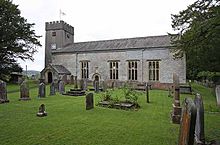St Paul's Church, Witherslack
| St Paul's Church, Witherslack | |
|---|---|

St Paul's Church, Witherslack, from the south
|
|
| Coordinates: 54°15′01″N 2°52′25″W / 54.2503°N 2.8736°W | |
| OS grid reference | SD 432,842 |
| Location | Witherslack, Cumbria |
| Country | England |
| Denomination | Anglican |
| Website | St Paul, Witherslack |
| History | |
| Founder(s) | John Barwick |
| Consecrated | June 1671 |
| Architecture | |
| Status | Parish church |
| Functional status | Active |
| Heritage designation | Grade II* |
| Designated | 12 February 1962 |
| Architectural type | Church |
| Style | Gothic |
| Groundbreaking | 1668 |
| Completed | 1768 |
| Specifications | |
| Materials | Stone, slate roof |
| Administration | |
| Parish | St Paul Witherslack |
| Deanery | Kendal |
| Archdeaconry | Westmorland and Furness |
| Diocese | Carlisle |
| Province | York |
| Clergy | |
| Vicar(s) | Revd Michael David Woodcock |
St Paul's Church is in the village of Witherslack, Cumbria, England. It is an active Anglican parish church in the deanery of Kendal, the archdeaconry of Westmorland and Furness, and the diocese of Carlisle. It is recorded in the National Heritage List for England as a designated Grade II* listed building. The authors of the Buildings of England series describe it as "an almost perfect example of a plain Gothic church of that date, honest and unpretentious".
The church was built between 1668 and 1669. It resulted from a bequest made by John Barwick, dean of St Paul's Cathedral, who died in 1664, to provide a burial place in the village of his birth, rather than the dead having to be carried across the tidal estuary of the river Kent for burial at St Michael's Church in Beetham. There had previously been a church in the village dedicated to Saint Mary, but this was ruined in the Civil War. John Barwick's brother, Peter, who was physician to Charles II, successfully petitioned the Bishop of Chester for a new church and a burial ground. The new church was a chapel of ease to the mother church at Beetham. The land for the church and burial ground were granted by the 8th Earl of Derby. The church was consecrated in June 1671 by the Bishop of Chester.
...
Wikipedia

